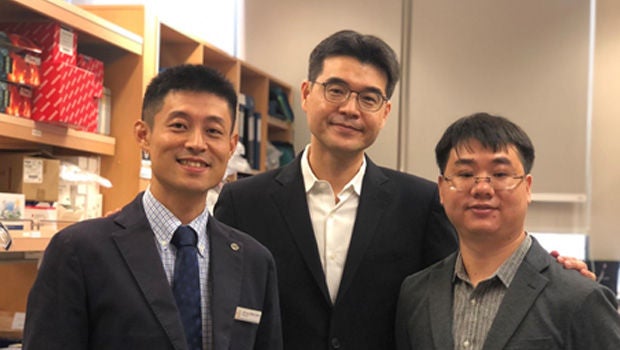
From left: Dr Alfred Sun, Junior Principal Investigator, Research, National Neuroscience Institute and Study Co-First Author; Prof Shawn Je Hyunsoo, Neuroscience and Behavioural Disorders Programme, Duke-NUS Medical School and Study Senior Author; and Dr Qiang Yuan, Study Co-First Author
New research discovers why epilepsy occurs in the neurodevelopmental disorder Angelman Syndrome (AS). This brings researchers closer to finding a treatment for seizures in people with AS and has the potential to benefit others with autism spectrum disorders.
A study led by Duke-NUS Medical School (Duke-NUS) and the National Neuroscience Institute (NNI) has identified a plausible drug target that could control and possibly prevent seizures in people with Angelman Syndrome (AS).
AS is a rare neurodevelopmental disorder that affects one in 15,000 live births. Symptoms include intellectual disability, minimal or no speech, poor sleep, a happy demeanour and seizures that are often resistant to treatment. It is caused by the deletion of chromosome 15q11-13 (UBE3A gene). This gene is also closely linked to autism, which affects about 1 in 150 children in Singapore, with up to 30 per cent having seizures.
The team discovered how the missing - gene in AS causes hyperactivity in brain neurons, bringing them closer to a treatment for seizures in people with AS, and possibly even for those with other autism spectrum disorders.
“We found that a specific molecule, known as the big potassium (BK) channel, was misregulated in neurons derived from AS patients’ cells, and this change seems to be responsible for frequent seizures in AS patients,” Dr Alfred Sun, Junior Principal Investigator at NNI and co-first author of the study, elaborated.
The team made the break-through by changing the way such research is conducted.
Existing studies normally use mouse models, the current go-to experimental models for biomedical research on AS. However, these have not been able to fully address the underlying mechanism of network hyperactivity leading to epileptic seizures observed in AS. This is because the functional differences resulting from UBE3A gene deficiency in mouse models are less pronounced that in human neuronal cells.
With this in mind, the research team from Duke-NUS and NNI, together with collaborators from the Genome Institute of Singapore (GIS), the Singapore Bioimaging Consortium (SBIC), the Agency for Science, Technology and Research (A*STAR), the National University of Singapore (NUS), and Duke University focused on studying the functional changes of human neurons induced from AS patient stem cells.
“Our study used 2D human neuronal cultures that enabled the accelerated discovery of functional differences at the individual cell level in the brains of normal individuals versus those with AS,” explained Associate Professor Hyunsoo Shawn Je, from Duke-NUS’ Neuroscience and Behavioural Disorders Programme, senior author of the study. “The use of 3D human ‘mini brains’ then allowed us to monitor spontaneous network activities, connecting the findings of abnormal firing by single neurons and seizure-like activities just like the ones observed in AS patient brains.”
With the identification of the dysfunctional BK channel, the researchers can now work towards developing a drug to suppress this channel.
Following on from this study, the research team is also developing a high-throughput drug-screening platform using human induced neurons to screen US Food and Drug Administration approved drugs that can potentially be repurposed for the treatment of epilepsy in people with AS. It is hoped the findings will lead to further insights and discoveries that will benefit many more people with related conditions, such as other forms of treatment-resistant epilepsy and seizures in people with autism spectrum disorders.













 Get it on Google Play
Get it on Google Play